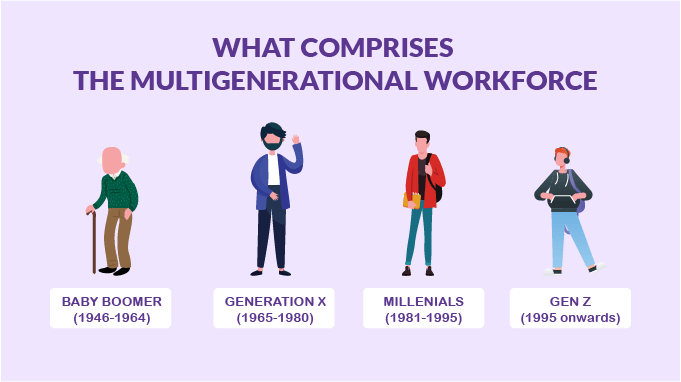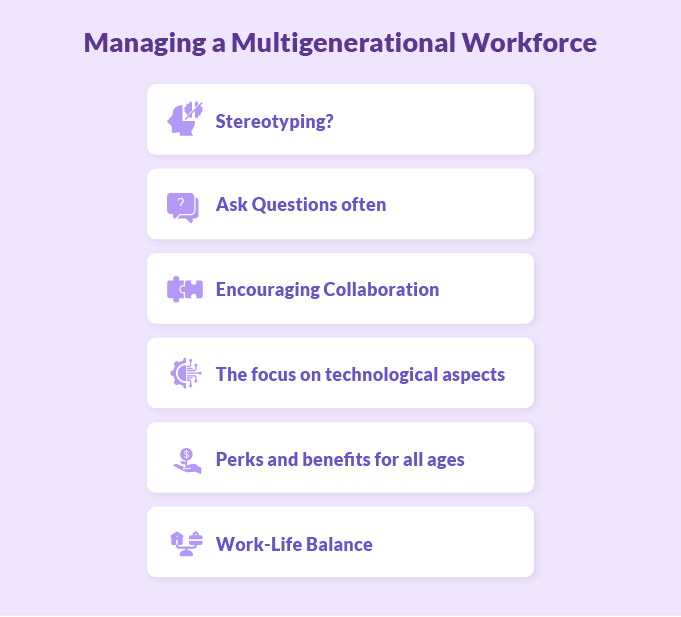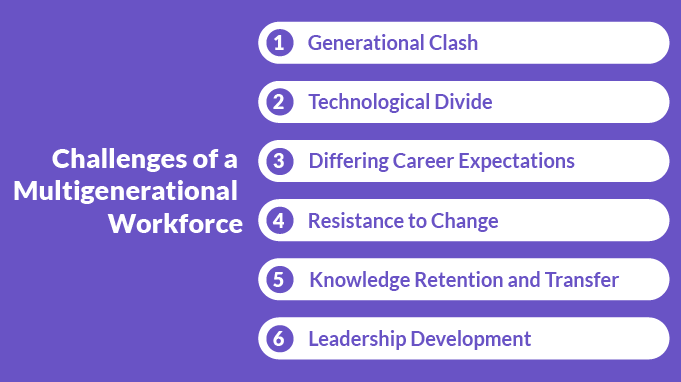Managing a multigenerational workforce: Benefits and Challenge
Change is constant, and that is true even for the workforce of an organization. The baby boomers are on the verge of retirement, while generation Y has taken up the workforce with a storm. But there is still a healthy mixture of employees that make up all the generations. And managing them can become an uphill task.
In this blog, we will be discussing how you can manage a multigenerational workforce.
Key Takeaways
- The generations that make up the multigenerational workforce
- How to manage a multigenerational workforce.
- Challenges of having a multigenerational workforce.
- Benefits of having a multigenerational workforce.
Who comprises the Multigenerational Workforce?

A workforce that consists of Baby Boomers (1946-1964), Generation X (1965-1980), Millennials (1981-1995), and Generation Z (Born after 1995) is known as the multigenerational workforce.
1. Baby Boomer: This is the generation that were born between 1946-1964. They are old school and believe in traditional ways of working.
2. Generation X: This generation was born between 1965-1980. They are often quite direct, adaptable and reliable.
3. Millennials: This generation comprises most of the workforce, making up a staggering 70%. They were born between 1981-1995 and are the most flexible generation as they have witnessed the transitions.
4. Gen-Z: This is the generation born after 1995. Generation Z will soon be completing graduation and will eventually join the corporate workforce shortly. They are technologically advanced and enjoy challenges while solving them with their creativity. They are the future assets of every organization, and it is crucial to invest in them to get the best out of them.
Each generation has a different set of skills and psychological presence in an organization. They have their way of approaching and completing a task. Providing organizations with ample opportunities to achieve their goals and objectives.
However, with the generation gap, situations can become challenging at a particular time. And this is where they effectiveness of your organizations’ management will come into play.
Managing a Multigenerational Workforce

Managing different sets of people from different generations is not easy; however, creating a sustainable environment is crucial for the organization’s success. Here are a few tips on creating one.
1. Stereotyping? Forget about it!
Different generations have varied skill sets. This can sometimes create a gap and lead to stereotyping each other. For example, Gen-Z might think that Baby Boomers and Millennials are too work-centric and have less technical proficiency. However, the older generation might feel that the current generation is not inclined and loyal to work.
Managing such a scenario becomes difficult. As a leader, you must maintain the balance. Stress the importance of team cohesion and how they can work together. The idea is to build positive connections between different generations. And you can do that with the help of good team-building activities.
Do a thorough study on each generation’s comfort zone and plan accordingly for a higher success rate.
2. Ask Questions often
The quickest path to understanding and connecting with your workforce is by asking them the right questions. Ask questions in a way that does not feel offensive. Always try to keep things neutral and friendly.
Excellent and thoughtful questions can turn out to be the start of a deep conversation. It gives you the right path to follow and acquire the necessary feedback. Some of the questions you can include are:
-
How satisfied are you with the current communication channels within our organization? (Scale: Very satisfied - Satisfied - Neutral - Dissatisfied - Very dissatisfied)
-
What type of professional development opportunities would you like to see offered? (Open-ended)
-
How would you rate the work-life balance support provided by the company? (Scale: Excellent - Good - Neutral - Fair - Poor)
-
In what ways do you feel our company could better accommodate diverse work styles and preferences? (Open-ended)
-
How comfortable do you feel providing feedback to your direct supervisor or management team? (Scale: Very comfortable - Comfortable - Neutral - Uncomfortable - Very uncomfortable)
You can practice Q&A sessions with everyone in the organization or find ways to communicate with people belonging to different generations. This will give you more insights into their thoughts process and their perspective of the workplace.
3. Encouraging Collaboration
A generational gap does not signify that they cannot be compatible. Yes, the work will be stressful to bring them on the same page. However, they must understand each other and collaborate well for success. And this is something that you as a leader need to highlight.
Conduct sessions where they can pitch their ideologies and thoughts. This will help each generation to see the differences in the way they work. This will also help enlighten the common grounds they can work on.
Additionally, when there is collaboration everyone will gain new knowledge coupled with experience and wisdom. Thus, fostering productivity in the multigenerational workforce.
Read more: Power Of Collaboration In The Workplace- Know It All Here
4. The Focus on Technological Aspects
Technology has always been an essential part of an organization and has evolved with time. Regardless of the generation, it will keep constantly changing, which will require quick understanding.
When we talk about technology and the multigenerational workforce, each one needs to adapt and acknowledge the change. You need to guide them and make them familiar with the situation that change is inevitable. They need to learn and relearn from scratch about all the technological changes that will affect their work.
This way, each employee in the organization, whether from the Baby Boomer generation or Generation Z, can upgrade their technological skills.
5. Perks and Benefits for all Ages
When it comes to the perks and benefits provided by any organization, every employee loves them. The multigenerational workforce that you manage does not thrive on monetary compensation alone. Along with money, extra benefits are necessary. This helps their morale and motivation levels.
It would help if you did not categorize perks based on their generation. It should be equal and enjoyed by everyone. Find benefit plans that are not biased with the age factor and are beneficial for everyone. This will not only help you retain your older employees, but it will also come as a benefit to the younger generation. You can provide them with a flexible gifting module where they can choose rewards according to their needs.
6. Work-Life Balance
According to statistics, 72% believe a healthy work-life balance is crucial during their tenure, which is correct and true. Without proper balance there are roadblocks and an increase in stress. And every generation goes through stress.
Providing everyone with the right work-life balance plan is crucial to managing them. This will help them mitigate burnout and focus more on what’s important. Additionally, it will also work as a morale booster and help the workforce start fresh. In the long run, it will enhance productivity and elevate job experience.
Read more: 25 Best Ways To Achieve Work-Life Balance and Its Benefits
Benefits of a Multigenerational Workforce

Today’s progressive workplace landscape focuses on harnessing the diverse strengths of different generations. It is not just a trend but a strategic imperative. Below is a list of benefits of embracing a mutigenerational workforce:
1. Innovation Fusion:
A multigenerational workforce consists of different age groups. And when they collaborate, magic happens. Since every other comes from a different generation, they bring a unique perspective. With varied experiences, it allows such a workforce to find innovative solutions to complex problems.
Hence, it is essential that you foster such a collaborative environment. Doing so will help in the free flow of ideas across different generations. Thus, allowing the organization to ignite a creative spark that drives and thrives in out of the box thinking.
2. Knowledge Transfer:
One great advantage of having a multigenerational workforce is knowledge transfer. There is a constant flow of knowledge from experienced employees to fresh talent. Experienced employees possess invaluable wisdom. On the other hand, the young counterparts offer fresh insights and technological prowess.
This exchange not only preserves institutional knowledge but also cultivates a culture of continuous learning. Thus, ensuring the organization remains agile and adaptive in a rapidly evolving market.
3. Enhanced Communication:
Effective communication works as a bridge between generational divides. It is a cornerstone of any successful organization that has a diverse workforce. With good communication organizations can cultivate a culture of open dialogue, mutual respect, and understanding.
It is critical to understand and leverage the different communication styles that fit your work culture best. From traditional face-to-face interactions to digital platforms, you can experiment with anything.
The end goal is to have a system in place that emphasizes good communication and helps in seamless collaboration of different generations. Doing so will enhance the productivity of the workforce while reducing the chances of any conflict. Moreover, when different age groups collaborate well it improves the bottom line and creates a good market presence.
Recommended Read: What are Communication Strategies & 10 Ways to Establish Them
4. Adaptive Leadership:
Leading a multigenerational workforce requires an approach that acknowledges and embraces everyone. As a leader, you need to focus on all the nuances associated with it. Forward-thinking leaders navigate the nuances and leverage each generation’s strength to drive organizational growth. And they do this with the help of different leadership styles which also helps in evolving them as leaders.
Through this approach organizations can cultivate a dynamic leadership pipeline that empowers individuals at every stage of their career journey.
5. Market Insight:
The current market is competitive and ever-changing. And to stay on top, organizations must stay attuned to shifting market trends and consumer preferences. With the help of a multigenerational workforce, organizations can tap into different market insights. The reason is that with such a workforce, you get diverse perspectives on evolving market dynamics.
All you need to do is-
-
Tap into the collective wisdom of different generations.
-
Anticipate emerging trends through feedback and asking for opinions.
-
Tailor products and services to meet evolving customer needs.
Doing things like this will give you a competitive edge while leveraging the opinions of your workforce.
6. Employee Engagement and Retention:
In a multigenerational workforce, employees feel valued, respected, and empowered to contribute their unique talents and perspectives. This sense of inclusivity fosters high levels of employee engagement and satisfaction, driving productivity, innovation, and ultimately, organizational success.
Moreover, by offering opportunities for professional development, mentorship, and career advancement across generations, organizations can attract top talent and retain key employees for the long haul.
And to boost your efforts in recognizing them, you can opt for virtual recognition platforms. These platforms are easy to use and come with varied capabilities. The goal of these platforms is to increase engagement and provide good employee experience. In the long run it helps in retention and overall satisfaction of the workforce that meet the diversified needs.

(Source: Vantage Rewards)
Challenges of a Multigenerational Workforce

While having a multigenerational workforce offers numerous benefits, it also comes with its challenges. Below are six key challenges organizations may encounter with such a workforce:
1. Generational Clash:
When you have a workforce of different generations, they come with different sets of values, beliefs, and work styles. This can sometimes lead to friction and misunderstanding within the workforce. For example, Baby Boomers may prefer face-to-face communication and rigid structures. But Millennials and Gen-Z employees may navigate towards digital communication and flat hierarchy.
This can create a roadblock towards achieving a unified workforce. Bridging these gaps will require empathy, open-mindedness, and a willingness to respect diverse perspectives. And this may take time, which will require proper planning and understanding of all the generations present.
2. Technological Divide:
Technological advances have increased in the past decade, influencing the digital divide between generations. The younger employees are digital natives and are comfortable with the latest technologies. At the same time, older employees may struggle to adapt to new digital tools and platforms.
This creates discord between these two sets of employees as one will be more inclined towards technology. In contrast, the other one might not. Solving such an issue might be difficult. However, with the right planning and training you can build confidence and navigate through digital landscapes. Thus, ensuring that technology serves as an enabler rather than a barrier to productivity and collaboration.
3. Differing Career Expectations:
With a diverse generation comes its own set of career expectations and priorities. Baby boomers might value stability, loyalty, and upward mobility within a single organization. While the millennials and Gen-Z employees prioritize flexibility, work-life balance, and skill development.
Balancing these diverse expectations requires flexible HR policies. Also, the career development initiative and recognition programs must be tailored accordingly. But it is easier said than done. This requires a strategic approach so that the unique needs and aspirations are fulfilled while focusing on employee satisfaction.
4. Resistance to Change:
Change is inevitable in today’s growing corporate sector and employees need to be open about it. However, it can be met with resistance, particularly among older generations accustomed to traditional working methods. Introducing new technologies, processes, or organizational structures may encounter roadblocks. Especially from employees who fear obsolescence or disruption to their established routines.
To tackle that you can:
-
Implement effective change management strategies.
-
Provide action plans with clear communication.
-
Take feedback from employees and understand their perspective.
Doing so will help you mitigate resistance and foster a culture of adaptability and resilience.
5. Knowledge Retention and Transfer:
One of the biggest challenges comes when an older employee retires or transitions out of the workplace. Such occurrences lead to organizations losing valuable institutional knowledge and expertise. Ensuring smooth knowledge transfer across generations requires-
-
Proactive succession planning.
-
Good mentorship programs.
-
Knowledge sharing initiatives.
However, to do that you need to develop programs that are not complicated and easier for the employees to engage with. Another challenge is to make time for the employees out of their busy schedules. It is essential not to hamper their daily work while indulging them in such sessions. The focus remains to keep the workforce productive while ensuring a smoother knowledge transfer.
6. Leadership Development:
Developing leaders capable of effectively managing and inspiring a multigenerational workforce presents its own set of challenges. Traditional leadership models may not resonate with younger generations. While older leaders may struggle to adapt their leadership style to accommodate changing workforce dynamics and expectations.
Investing in leadership development programs should emphasize on-
-
Empathy.
-
Cross-generational communication, and
-
Inclusive leadership practices.
This will empower leaders at all levels to navigate complexities of a multigenerational workforce. In the long run, it fosters a culture of collaboration, innovation, and mutual respect.
Over to You!
These are just a few ideas from where you can start and build a positive network with your multigenerational workforce. You can get creative and find ways to manage them well that will benefit them and you in the long run.

















